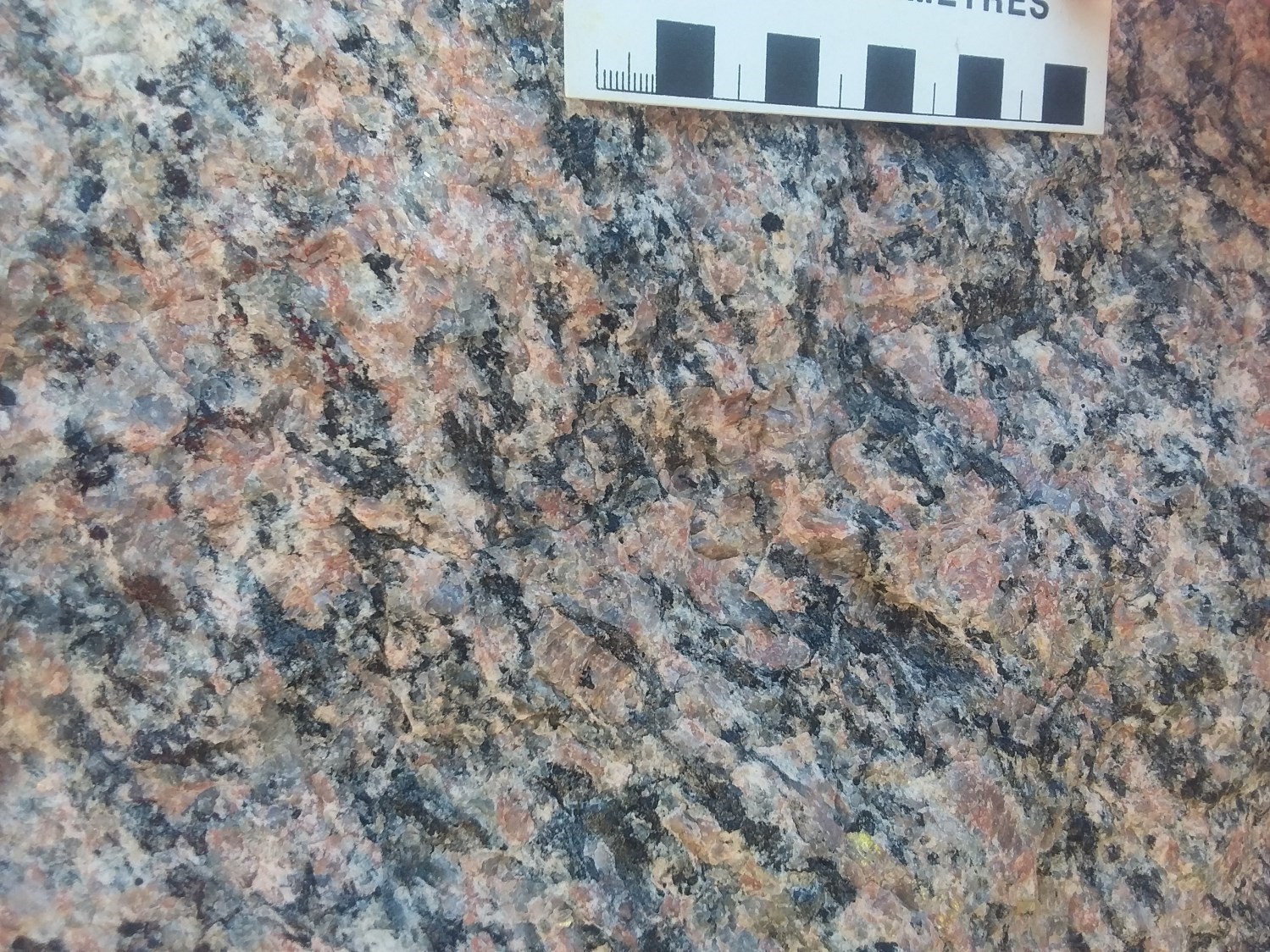
Last modified: 17 January 2020
Translation of original French
| Author: | Moukhsil and Daoudene, 2019 |
| Age: | Mesoproterozoic |
| Reference section: | Reference outcrop 18-AM-137 located on Sainte-Hedwidge Road |
| Type area: | Village of Sainte-Hedwidge (northern part of NTS sheet 32A08) |
| Geological province: | Grenville Province |
| Geological subdivision: | Allochton |
| Lithology: | Felsic, intermediate, mafic intrusive rocks |
| Type: | Lithodemic |
| Rank: | Suite |
| Status: | Formal |
| Use: | Active |
None
Background
The Sainte-Hedwidge Intrusive Suite was defined by Moukhsil and Daoudene (2019) during the mapping of the southwestern region of Lake Saint-Jean (NTS sheet 32A08).
Description
The Sainte-Hedwidge Intrusive Suite is a polyphase batholith whose composition varies from gabbronorite to granite through syenite. It is subdivided into two informal units, mPshe1 and mPshe2, which are kilometre-thick and very magnetic. They are easily identifiable on aeromagnetic maps (Intissar and Benahmed, 2015).
Sainte-Hedwidge Intrusive Suite 1 (mPshe1): Quartz Monzodiorite, Jotunite, Quartz Monzonite, Gabbronorite, Minor Amounts of Syenogranite and Monzogranite
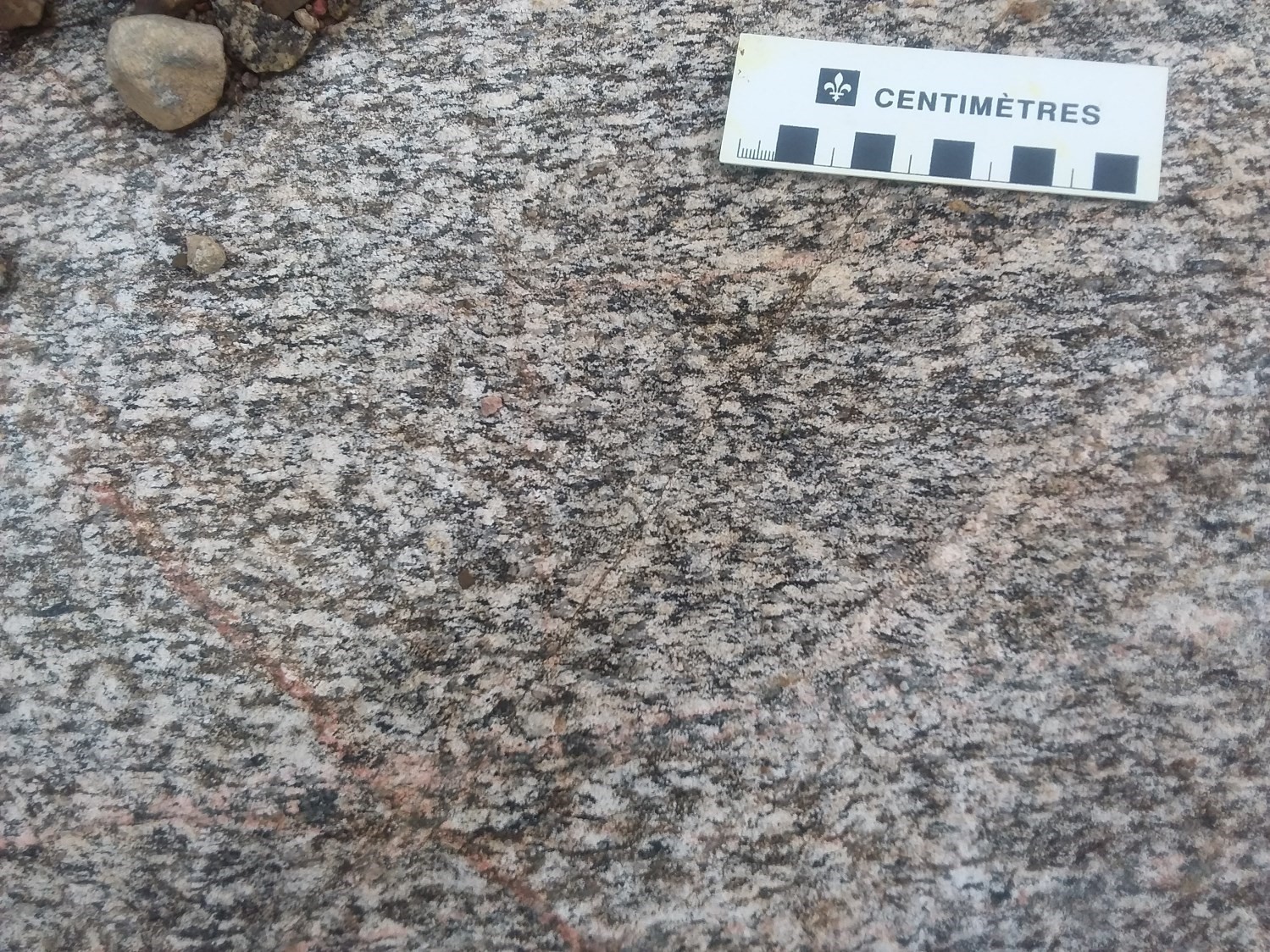
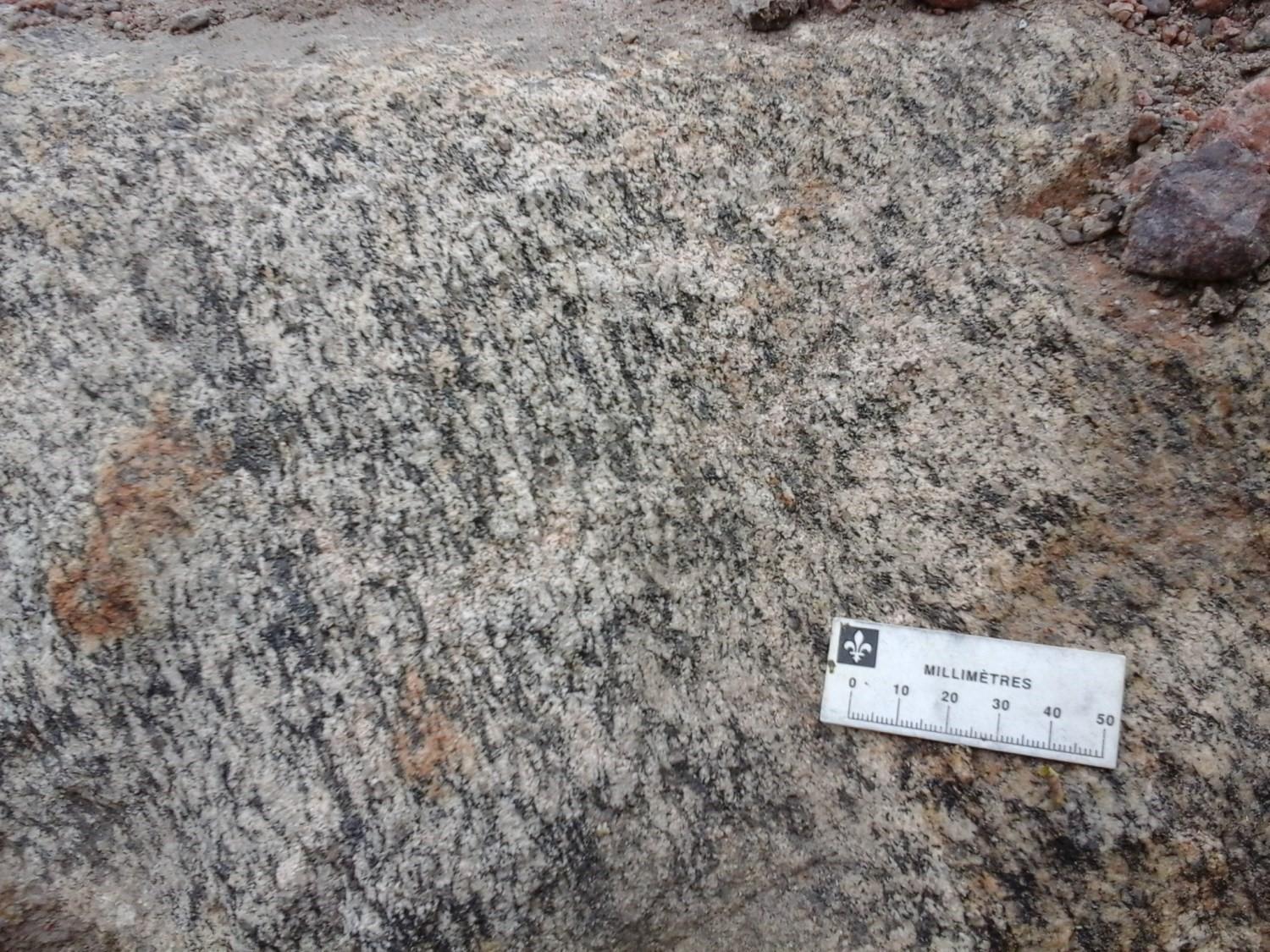 Unit mPshe1 consists of intermediate (quartz monzodiorite, jotunite, quartz monzonite), mafic (gabbronorite) and felsic (syenogranite and monzogranite) rocks. Quartz monzodiorite is greyish and speckled in altered patina and grey-black in fresh exposure. It is composed of quartz displaying undulatory extinction, sericitized plagioclase containing greyish inclusions (K-feldspar), ferromagnesian mineral (green hornblende, biotite) clusters elongated along foliation and accessory minerals such as apatite, zircon and titanite. It is coarse grained and locally porphyroclastic. Quartz monzodiorite also contains centimetric, foliated and fine-grained gabbro enclaves.
Unit mPshe1 consists of intermediate (quartz monzodiorite, jotunite, quartz monzonite), mafic (gabbronorite) and felsic (syenogranite and monzogranite) rocks. Quartz monzodiorite is greyish and speckled in altered patina and grey-black in fresh exposure. It is composed of quartz displaying undulatory extinction, sericitized plagioclase containing greyish inclusions (K-feldspar), ferromagnesian mineral (green hornblende, biotite) clusters elongated along foliation and accessory minerals such as apatite, zircon and titanite. It is coarse grained and locally porphyroclastic. Quartz monzodiorite also contains centimetric, foliated and fine-grained gabbro enclaves.
Jotunite (hypersthene monzodiorite) is similar to quartz monzodiorite at all points except that the former contains hypersthene (5% of the rock). Quartz monzonite is beige-pink in altered patina and salmon pink in fresh exposure. It contains K-feldspar, plagioclase, biotite and hornblende. It is foliated, K-feldspar porphyritic and locally porphyroclastic.
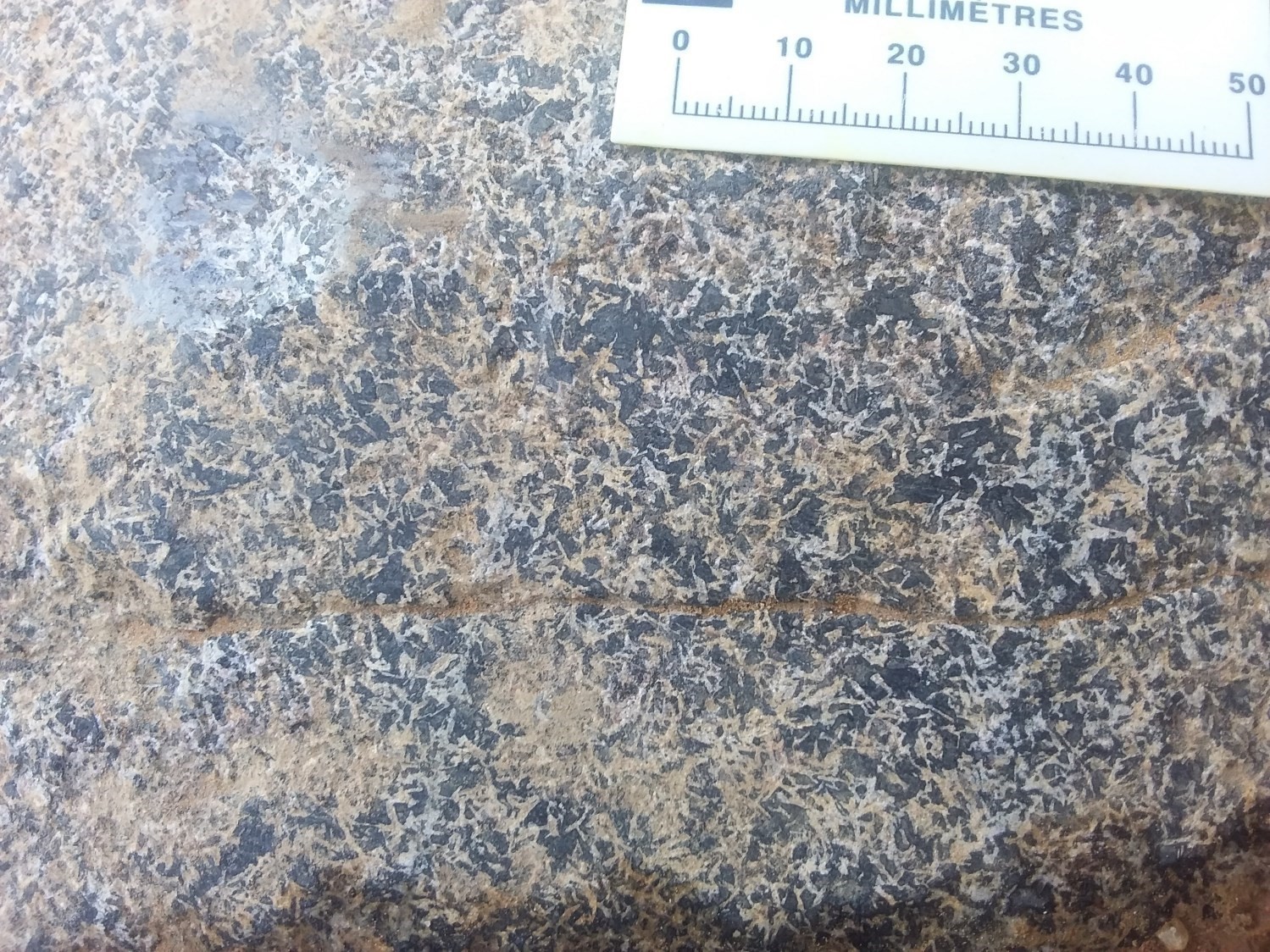 Gabbronorite is observed in several places in the intrusion and appears to be intruding into the unit’s intermediate facies. It is massive and has an ophitic to subophitic texture, containing ~55% green hornblende and 40% sericitized plagioclase. The rest of the rock consists of small garnet grains and chloritized and epidotized (pistachite) biotite crystals. In several locations, gabbronorite contains orthopyroxene.
Gabbronorite is observed in several places in the intrusion and appears to be intruding into the unit’s intermediate facies. It is massive and has an ophitic to subophitic texture, containing ~55% green hornblende and 40% sericitized plagioclase. The rest of the rock consists of small garnet grains and chloritized and epidotized (pistachite) biotite crystals. In several locations, gabbronorite contains orthopyroxene.
Syenogranite and monzogranite, which account for a small proportion of this suite, outcrop locally as intrusions into the remaining facies of this unit.
Sainte-Hedwidge Intrusive Suite 2 (mPshe2): Quartz Syenite, Mangerite, Syenogranite, Alkaline Feldspar Granite, Gabbronorite, Granitic Gneiss and Paragneiss Enclaves
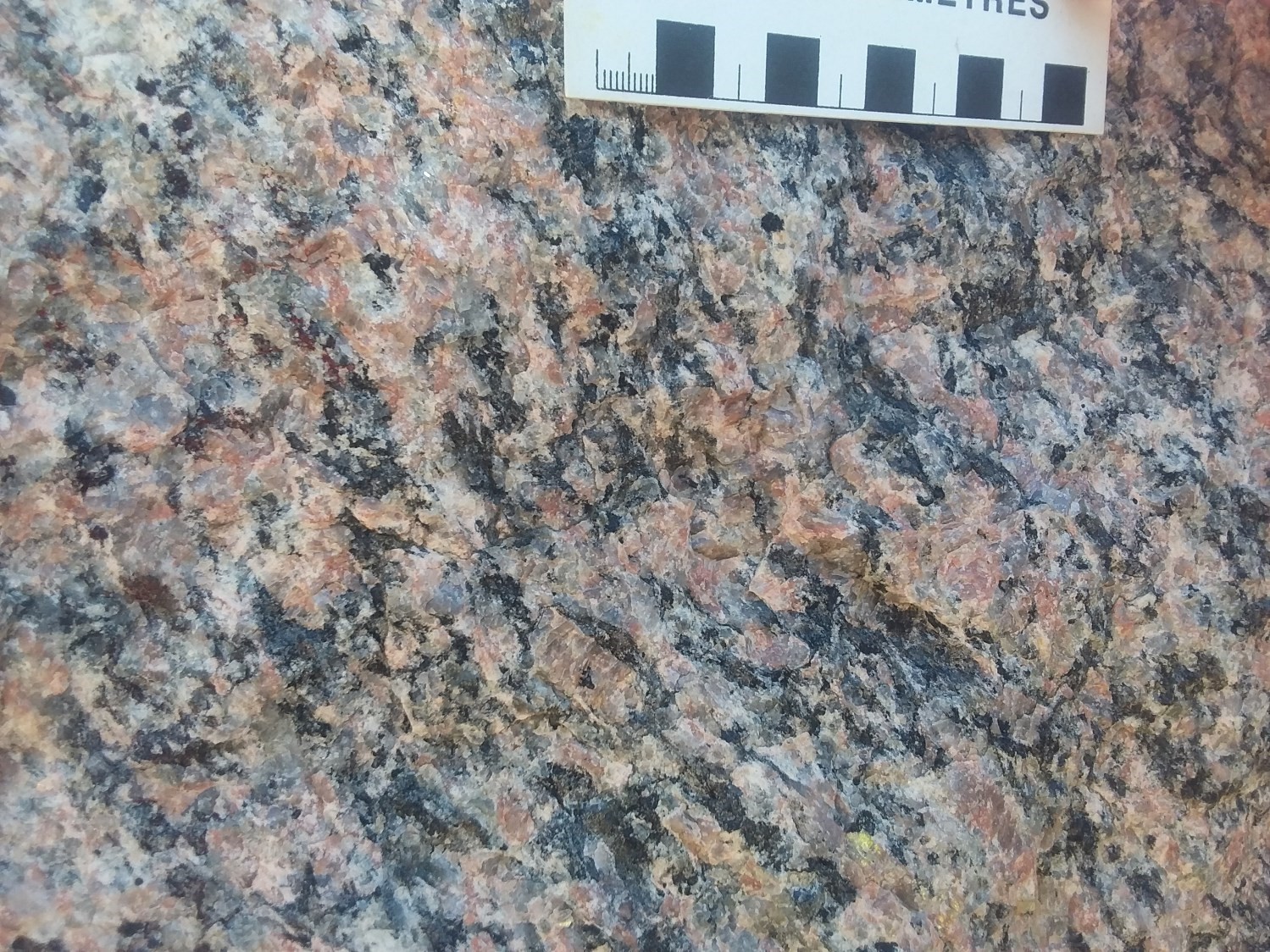
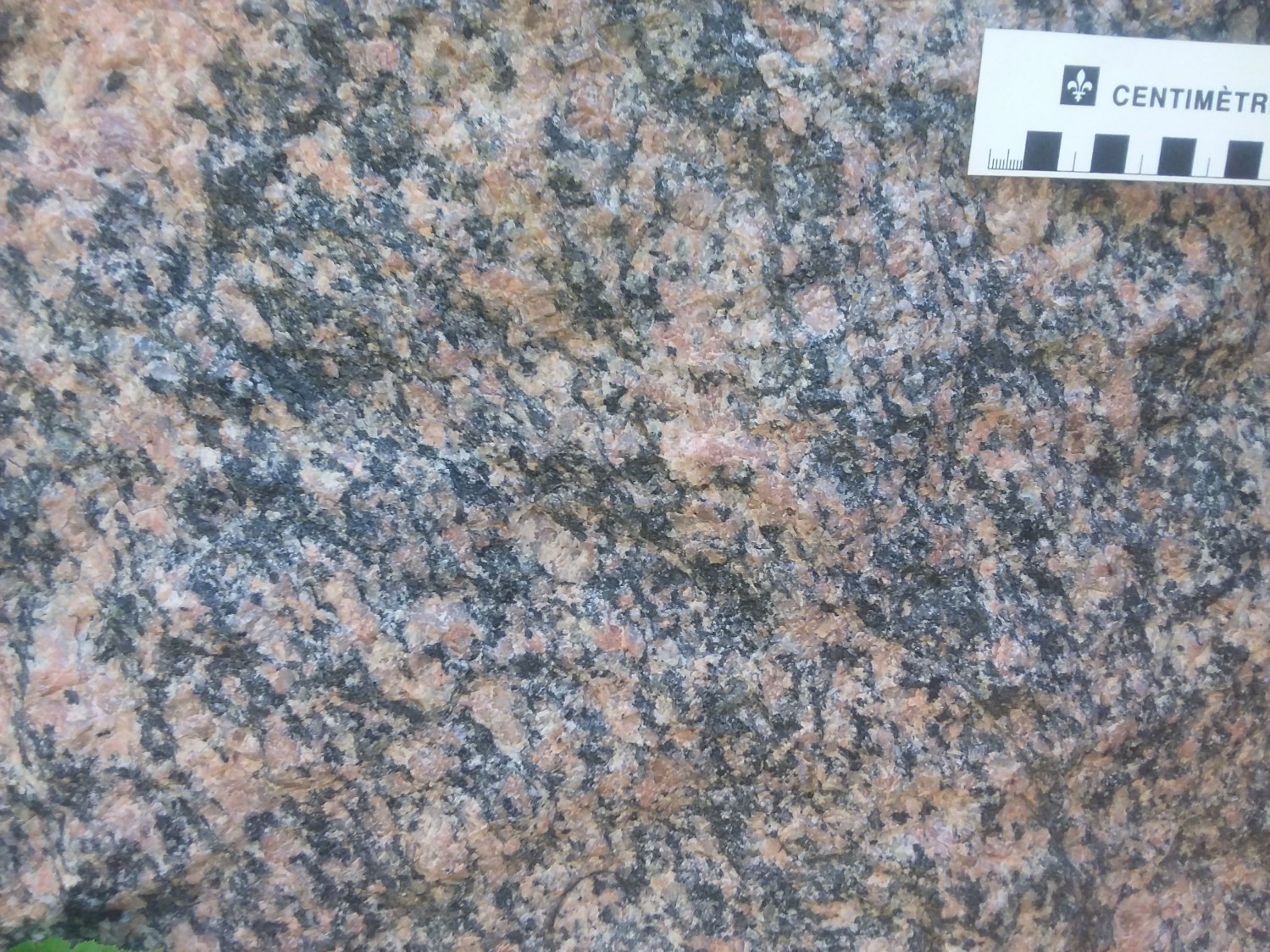 Unit mPshe2 consists mainly of quartz syenite, mangerite, syenogranite and alkaline feldspar granite. Some outcrops of this unit consist of gabbronorite and rarely granitic gneiss. Syenogranite is pink-grey in altered patina and pink in fresh exposure. It is massive and commonly K-feldspar-plagioclase porphyritic. Phenocrystals are 2 to 3 cm long and form about 25% of the rock. Quartz syenite and alkaline feldspar granite are difficult to distinguish in the field because the quartz content varies from one outcrop to another (6-25%). They are both greyish to salmon pink in fresh exposure and K-feldspar porphyritic, diplaying phenocrystals throughout the rock.
Unit mPshe2 consists mainly of quartz syenite, mangerite, syenogranite and alkaline feldspar granite. Some outcrops of this unit consist of gabbronorite and rarely granitic gneiss. Syenogranite is pink-grey in altered patina and pink in fresh exposure. It is massive and commonly K-feldspar-plagioclase porphyritic. Phenocrystals are 2 to 3 cm long and form about 25% of the rock. Quartz syenite and alkaline feldspar granite are difficult to distinguish in the field because the quartz content varies from one outcrop to another (6-25%). They are both greyish to salmon pink in fresh exposure and K-feldspar porphyritic, diplaying phenocrystals throughout the rock.

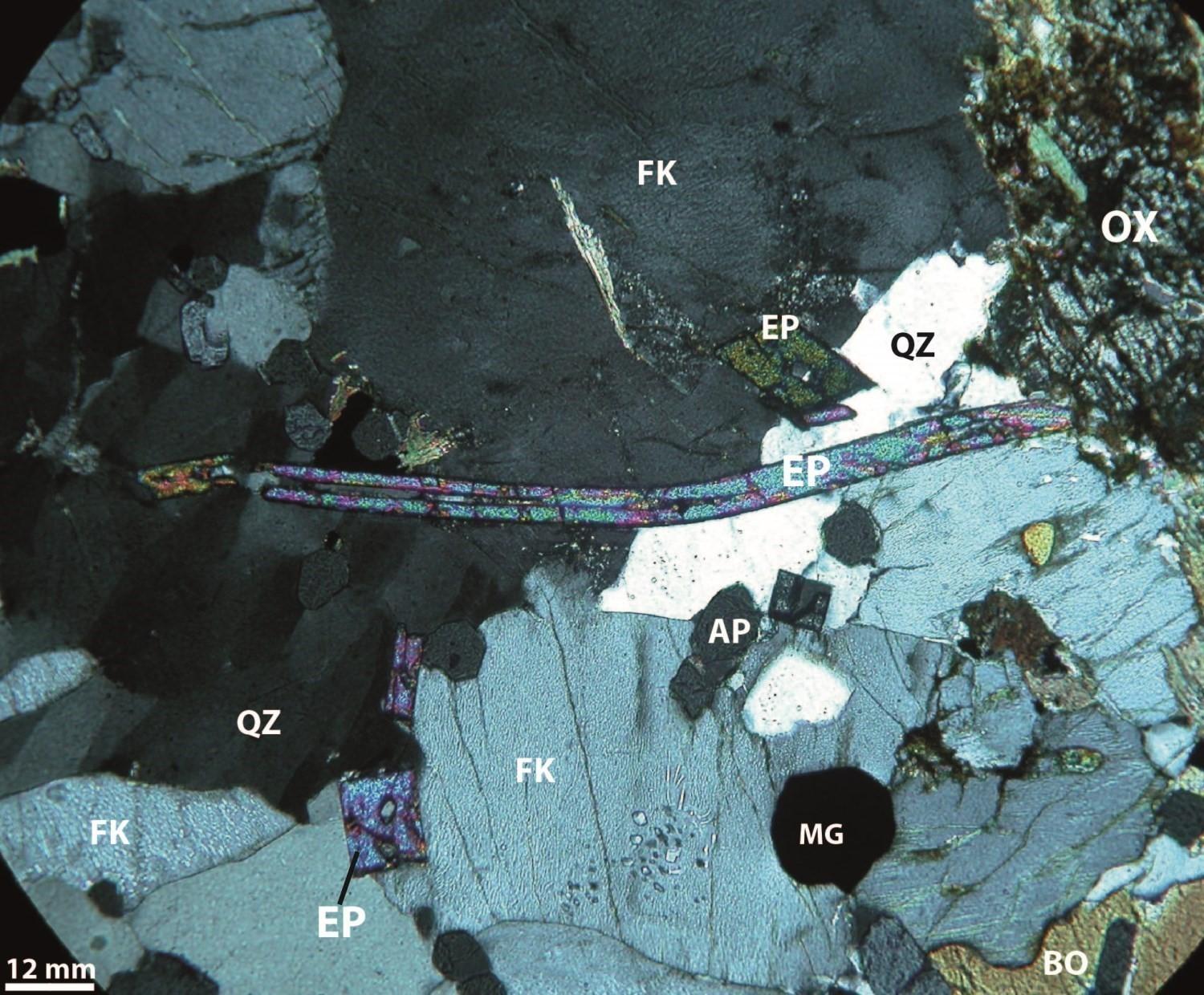 Mangerite is medium to coarse grained, locally perthitic K-feldspar porphyritic and greenish in fresh exposure. It is highly magnetic (presence of magnetite). Its mineralogy consists of quartz exhibiting undulatory extinction, altered orthopyroxene, locally uralitized with a hornblende rim, sericitized plagioclase, biotite and euhedral to subhedral crystals of magmatic epidote (typical outcrop 18-AM-81A). Ferromagnesian minerals form clusters that contain inclusions of euhedral apatite crystals.
Mangerite is medium to coarse grained, locally perthitic K-feldspar porphyritic and greenish in fresh exposure. It is highly magnetic (presence of magnetite). Its mineralogy consists of quartz exhibiting undulatory extinction, altered orthopyroxene, locally uralitized with a hornblende rim, sericitized plagioclase, biotite and euhedral to subhedral crystals of magmatic epidote (typical outcrop 18-AM-81A). Ferromagnesian minerals form clusters that contain inclusions of euhedral apatite crystals.
Syenogranite is medium to coarse grained, foliated and contains quartz, K-feldspar, plagioclase and hornblende. Alkaline feldspar granite is salmon pink in fresh and altered surfaces. It is fine to medium grained and composed of microcline, large quartz zones displaying undulatory extinction, biotite and accessory minerals (zircon, epidote, apatite). Gabbronorite is coarse grained, granoblastic and shows the same mineralogy as unit mPshe1, but without the ophitic texture. Granitic gneiss is banded and contains alternating grey bands and K-feldspar-rich pink bands. It is generally observed at the edge of the intrusion and could be a metasedimentary facies intruded by granitic dykes, all of which have been extensively transposed following extensive deformation. In fact, decametric klippes of metasedimentary rocks (Barrois Complex) are observed in this unit.
Thickness and Distribution
This unit is located in the northern region of sheet 32A08. Interpretation of regional aeromagnetic maps indicates its extension in sheet 32A09 (Intissar and Benahmed, 2105). It is roughly N-S oriented and has a long axis of 36 km and a maximum width of 14 km (centre of intrusion). Unit mPshe2 is very magnetic and easily identifiable on aeromagnetic maps, whereas only the centre of unit mPshe1 is magnetic.
Dating
A dating on the sample 2018-AM-0137A was recently carried out.
| Unit | Sample Number | Isotopic System | Mineral | Crystallization Age (Ma) | (+) | (-) | Reference(s) |
| mPshe | 2018-AM-0137A | U-Pb | Zircon | 1017 | 36 | 36 | Papapavlou, 2019 |
Stratigraphic Relationship(s)
The Sainte-Hedwidge Intrusive Suite is in fault contact with the Travers Suite and the Thaddé Plutonic Suite. It contains paragneiss from the Barrois Complex (mPboi4), and is intruded by centimetric to metric dykes of diorite and granitic to syenitic pegmatites.
Paleontology
Does not apply.
References
Publications available through Sigéom Examine
INTISSAR, R., BENAHMED, S. 2015. LEVE MAGNETIQUE AEROPORTE DANS LE SECTEUR OUEST DU LAC-ST-JEAN, PROVINCE DE GRENVILLE. MERN, GOLDAK AIRBORNE SURVEYS. DP 2015-06, 7 pages and 2 plans.
MOUKHSIL, A., DAOUDENE, Y. 2019. Géologie de la région du lac des Commissaires, Province de Grenville, région du Saguenay–Lac-Saint-Jean, Québec, Canada. MERN. BG 2019-01.
PAPAPAVLOU, K. 2019. U-Pb geochronology report, Grenville 2018-2019. UQAM. MB 2019-11, 21 pages.

